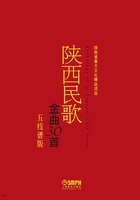
Preface
Shaanxi folk Songs and the Culture of Chinese Folk Music
Zhao Jiping (Chairman of Chinese Musicians Association)
In the wealthy culture of the Chinese folk music,Shaanxifolk songsare a major branch most representative and characteristic of both the Chinese indigenous culture and the Chinese national spirit.Consisting of three types defined by the regions where they originated and spread, these folk songs have inherited the essence of two primary Chinese cultural traditions.The northern and central Shaanxi folk songs, the latter also known as Guanzhong folk songs,were cultivated in the center of the Yellow River civilization, while folk songs from southern Shaanxi, born in the area along the Hanjiang River, the biggest tributary of the Yangtze River,were shaped by the southern Chinese civilization represented by the longest river of China.As part of the Chinese national culture, folk songs have almost always evolved on the basis of agricultural civilization. In Shijing (Classic of Poetry),the oldest collection of Chinese poetry, half of the 305 works come from the land of Shaanxi Province; the very beginning of this cherished heritage, Crying Ospreys,originated from Zhounan area, now the town of Hechuan, Shaanxi.
Unfortunately, the Chinese folk songssuffer from the loss of most of its music dueto the lack of sufficient notation, a problem shared with many other ancient musical cultures.As a result,only a very small and thus precious part of music has been preserved through an oral tradition.
In the history of conscious preservation of folk music in modern times, one of the early majorevents is the foundation of the Institute of Chinese Folk Song Studies (later renamed as the Institute of Chinese Folk Music Studies) in Yan'an 1939,the first organization,with its 19 members,dedicated to this field.These musicians spent three years gathering more than 2000 folk songs and compiled them into the first collection dominated by northern Shaanxi folk songs. A large-scale movement of singing and spreading northern Shaanxi folk songs began in l942 and had profound influence on the stylistic features and aesthetics of later Chinese music.
After the foundation of People's Republic of China, Chinese Musicians Association initiated in the l960s a national activity of collection folk songs.Among the 400,000 songs collected, there were nearly l5,000 coming from Shaanxi, making it one of the provinces richest in folk songs. The remarkable Collections of Chinese Folk Songs, including 400,000 songs in 30 volumes, was finally completed in l994. Compiled and edited by Ministry of Culture, State Nationalities Affairs Commission and Chinese Musicians Association, they are the first official chorographical official chorographical collection offolk songs in China. The Shaanxi volume had l308 songs, among which there are 594 from the northern region, 256 the central and 458 the southern.
Since the beginning of the 21 st century, the government hasbeen reinforcing the preservation of cultural traditions. Several subgenres of Shaanxi folk songs have been included into List of the National Intangible Cultural Heritage. On the other hand, great changes in modern life and society also pose various new challenges to the existence and prospect of folk songs, which is a topic causing more and more concern.
Anthology of 30 Shaanxi Folk Songs is a collective effort made by Shaanxi musicians to reinvigorate this time-honored tradition, on which much of their own artistic creation has been built.Selecting 30 most representative and popular songs and transforming them into art music, this anthology aims to invest the old austere music with contemporary zeitgeist and proper artistic sophistication, making it more accessible in the modern urban life.
The anthology includes 10 northern Shaanxi folk songs,10 revolutionary folk songs, 5 Guanzhong folk songs and 5 southern Shaanxi folk songs. It is the first folk song collection on provincial level with both numbered musical notation and scores of piano accompaniment. Drawing on earlier experience, the arrangement of these songs gives nwe interpretation to old folk music with modern perspective and techniques.
Art knows no perfection. As compilers and arrangers of this anthology, we are fully aware of the possible defects in our work. However,it is our humble hope that this attempt could draw more and closer attention from musicians all over China, especially the young generation, to the responsibility of keeping our musical living tradition continuously alive.
2014.7.20, Xi'an